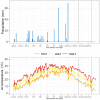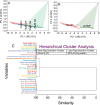Combined effect of gallic acid and zinc ferrite nanoparticles on wheat growth and yield under salinity stress
- PMID: 38834735
- PMCID: PMC11150583
- DOI: 10.1038/s41598-024-63175-9
Combined effect of gallic acid and zinc ferrite nanoparticles on wheat growth and yield under salinity stress
Abstract
Salinity stress significantly impacts crops, disrupting their water balance and nutrient uptake, reducing growth, yield, and overall plant health. High salinity in soil can adversely affect plants by disrupting their water balance. Excessive salt levels can lead to dehydration, hinder nutrient absorption, and damage plant cells, ultimately impairing growth and reducing crop yields. Gallic acid (GA) and zinc ferrite (ZnFNP) can effectively overcome this problem. GA can promote root growth, boost photosynthesis, and help plants absorb nutrients efficiently. However, their combined application as an amendment against drought still needs scientific justification. Zinc ferrite nanoparticles possess many beneficial properties for soil remediation and medical applications. That's why the current study used a combination of GA and ZnFNP as amendments to wheat. There were 4 treatments, i.e., 0, 10 µM GA, 15 μM GA, and 20 µM GA, without and with 5 μM ZnFNP applied in 4 replications following a completely randomized design. Results exhibited that 20 µM GA + 5 μM ZnFNP caused significant improvement in wheat shoot length (28.62%), shoot fresh weight (16.52%), shoot dry weight (11.38%), root length (3.64%), root fresh weight (14.72%), and root dry weight (9.71%) in contrast to the control. Significant enrichment in wheat chlorophyll a (19.76%), chlorophyll b (25.16%), total chlorophyll (21.35%), photosynthetic rate (12.72%), transpiration rate (10.09%), and stomatal conductance (15.25%) over the control validate the potential of 20 µM GA + 5 μM ZnFNP. Furthermore, improvement in N, P, and K concentration in grain and shoot verified the effective functioning of 20 µM GA + 5 μM ZnFNP compared to control. In conclusion, 20 µM GA + 5 μM ZnFNP can potentially improve the growth, chlorophyll contents and gas exchange attributes of wheat cultivated in salinity stress. More investigations are suggested to declare 20 µM GA + 5 μM ZnFNP as the best amendment for alleviating salinity stress in different cereal crops.
Keywords: Antioxidant; Chlorophyll content; Gallic acid; Growth attributes; Zinc ferrite nanoparticles.
© 2024. The Author(s).
Conflict of interest statement
The authors declare no competing interests.
Figures










Similar articles
-
Potential of kaempferol and caffeic acid to mitigate salinity stress and improving potato growth.Sci Rep. 2024 Sep 17;14(1):21657. doi: 10.1038/s41598-024-72420-0. Sci Rep. 2024. PMID: 39294197 Free PMC article.
-
Effect of silicon nanoparticle-based biochar on wheat growth, antioxidants and nutrients concentration under salinity stress.Sci Rep. 2024 Mar 16;14(1):6380. doi: 10.1038/s41598-024-55924-7. Sci Rep. 2024. PMID: 38493184 Free PMC article.
-
Investigating the growth promotion potential of biochar on pea (Pisum sativum) plants under saline conditions.Sci Rep. 2024 May 13;14(1):10870. doi: 10.1038/s41598-024-59891-x. Sci Rep. 2024. PMID: 38740776 Free PMC article.
-
Is Silicon a Panacea for Alleviating Drought and Salt Stress in Crops?Front Plant Sci. 2020 Aug 18;11:1221. doi: 10.3389/fpls.2020.01221. eCollection 2020. Front Plant Sci. 2020. PMID: 32973824 Free PMC article.
-
Combined Boron Toxicity and Salinity Stress-An Insight into Its Interaction in Plants.Plants (Basel). 2019 Sep 23;8(10):364. doi: 10.3390/plants8100364. Plants (Basel). 2019. PMID: 31547605 Free PMC article. Review.
Cited by
-
Application of nanoparticles for salinity stress management and biofortification in wheat: a review of dual approaches and insights.Front Plant Sci. 2025 Jul 4;16:1592866. doi: 10.3389/fpls.2025.1592866. eCollection 2025. Front Plant Sci. 2025. PMID: 40688693 Free PMC article. Review.
-
Bioactive compounds in extracts from short rotation willow shoots known as pharmaceuticals and experimental demonstration of biostimulation of maize plants by these chemical complexes.Front Plant Sci. 2025 Aug 4;16:1650824. doi: 10.3389/fpls.2025.1650824. eCollection 2025. Front Plant Sci. 2025. PMID: 40831725 Free PMC article.
References
MeSH terms
Substances
LinkOut - more resources
Full Text Sources

